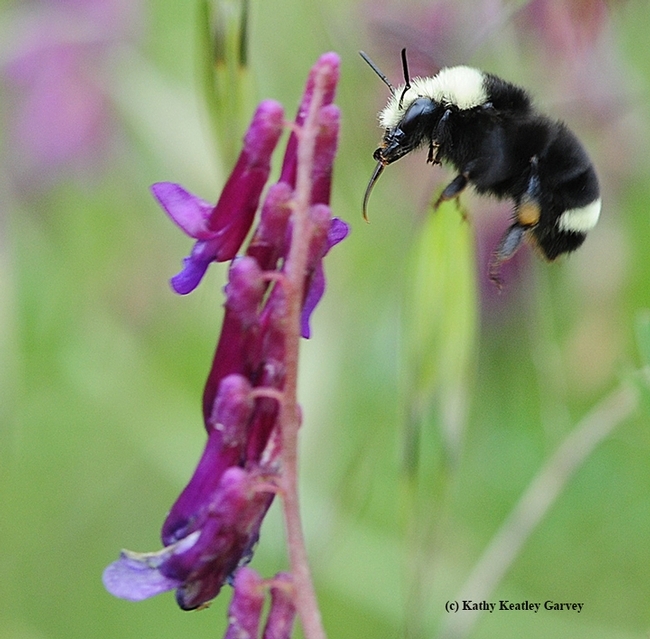
As avid gardeners,we often choose landscape plants that attract bees and insects, but what if the very plants we purchase contribute to the decline of these garden visitors?
If seeds, plants or flowers have recently been treated with neonicotinoid pesticide, these plants may do more harm than good. First developed in the 1980s, neonicotinoids (neonics) are the first new class of broad-spectrum pesticides in over 50 years.Then eonicotinoid group includes imidacloprid, one of the most popular garden insecticides sold in stores.
Neonics are widely used in horticulture and agriculture for a variety of pests. Like most powerful insecticides, they affect the insect nervous system; however, neonics themselves are comparatively safe for birds and mammals.
A systemic pesticide, neonics are absorbed by the plant and transferred through its vascular system. Consequently, the plant and, to some degree, its nectar and pollen become toxic to insects. The toxin remains active in the plant for weeks and detectable in the soil for years.
Untreated plants can absorb these chemicals from treated plants nearby. As pollinators feed on these plants, they may be exposed to the pesticide. This exposure can have a variety of effects, depending on dose and sensitivity.
Effects on an insect can include disorientation, a weakening of the immune system and death. Even slight exposure to neonicotinoids can affect some bees' ability to navigate or detect odors, impairing their ability to forage for food. While this may seem like it's better than dying, a bee that can't forage effectively may be as good as dead.
In 2013, European Union member states voted to prohibit the use of three neonicotinoids—imidacloprid, clothianidin and thiamethoxam on flowering plants and some crops. A mass die-off of bumblebees in Oregon that same year was attributed to a misapplication of neonicotinoids on linden trees. This outcome led Oregon authorities to adopt permanent restrictions on dinotefuran and imidacloprid, both neonics.
While neonics have little effect on honeybees, they can have profound effects on native solitary bees and bumblebees. These species don't get the headlines that honeybees do, but they are important pollinators.
Many home and garden retailers have already agreed to eliminate neonic-treated plants from their nurseries. When purchasing a plant that is or soon will be in bloom, look for a tag that states that it is neonic-free.
When applying pesticides, read labels carefully. Look for warnings that the pesticide may have adverse effects on pollinators. Follow application instructions, both for your own safety and to avoid killing non-target insects such as pollinators. Consider the consequences of using systemic insecticides containing imidacloprid, clothianidin, thiamethoxam, acetamiprid and dinotefuran, especially on blooming plants attractive to bees.
Avoid combined fertilizer-insecticide products as many of these contain broad-spectrum insecticides. Use safer products such as horticultural oils or soaps. More importantly,practice Integrated Pest Management techniques to control garden pests.Visit http://www.ipm.ucdavis.edu/ for more information on these methods.
Broad-spectrum insecticides are not selective. They can kill beneficial insects like ladybugs as well as other predators and parasites that control pests. That said, neonics don't kill all insects that land on a plant, only insects that eat the plant or its parts. Unfortunately, this can include bees and other beneficial insects if the plant is, or soon will be, in flower and attractive to bees. On plants that are wind pollinated, such as oaks and grasses, this is less of a concern.
Bees and other pollinators pollinate 70 percent of the world's flowering plants, and more than 30 percent of the plants that produce food. As informed gardeners, we have choices. We can purchase safe garden plants and flowers and limit our use of neonics. Creating pollinator-friendly gardens as a food source for beneficial insects is one step to protecting all bees and pollinators.
Workshop: U. C. Master Gardeners of Napa County will host a workshop on “Fruit Tree Pruning and Care” on Saturday, January 16, from 9:30 a.m. to 2 p.m. The workshop includes a lecture session from 9:30 a.m. to 11:30 a.m. at the University of California Cooperative Extension office, 1710 Soscol Avenue, Napa. A hands-on session at a local orchard follows, rain or shine, from 12:30 p.m. to 2 p.m. Please dress for outside weather. On-line registration (credit card only); Mail-in/Walk-in registration (cash or check only).
Master Gardeners are volunteers who help the University of California reach the gardening public with home gardening information. U. C. Master Gardeners of Napa County ( http://ucanr.org/ucmgnapa/) are available to answer gardening questions in person or by phone, Monday, Wednesday and Friday, 9 a.m. to Noon, at the U. C. Cooperative Extension office, 1710 Soscol Avenue, Suite 4, Napa, 707-253-4143, or from outside City of Napa toll-free at 877-279-3065. Or e-mail your garden questions by following the guidelines on our web site. Click on Napa, then on Have Garden Questions? Find us on Facebook under UC Master Gardeners of Napa County.